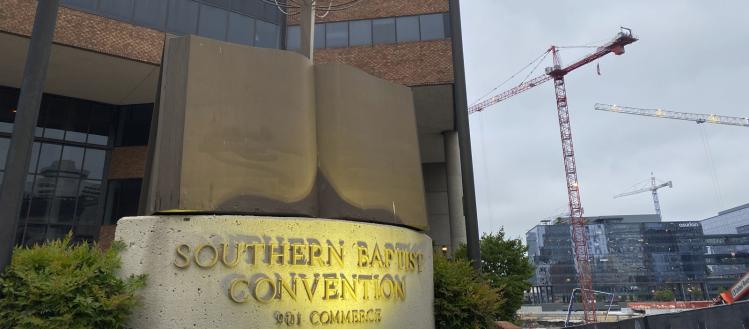
The independent report acknowledging hundreds of instances of sexual abuse by pastors, employees, and volunteers of the Southern Baptist Convention has the nation’s largest Protestant denomination reeling. And judging from the initial reactions of SBC leaders, it has little idea of how to handle what might come next, even as it prepares for its annual meeting in June.
But anyone who has observed the experience of the Catholic Church over the past twenty years might be able to predict what the coming months and years will bring. True, differences in ecclesial organization will make for fundamentally different questions and determinations about culpability, liability, and reform. Significantly, the legal landscape is very different today—largely because of changes brought about by the Catholic abuse scandals. But Southern Baptists have arrived at a moment that will completely absorb their denomination for a decade or more, threatening its moral and financial foundations.
I was twenty-two when I moved to Boston in December 2002, the day after the Vatican announced that Pope John Paul II had accepted Cardinal Bernard Law’s resignation. At the time, I could not have named a single U.S. Catholic bishop. Only vaguely aware of the scandal in Boston and other dioceses and clueless about its scale, I was struck by the Boston Globe’s massive headline, CARDINAL LAW RESIGNS, under a red “special edition” banner across the top of the front page. During my eighteen months in Boston, I followed the trial of John Geoghan, the disgraced priest who would soon be murdered in prison. I noted that Law’s replacement, Sean O’Malley, had some experience leading dioceses through sex abuse scandals, most recently in my native Florida. But I completed my studies in what now seems like stunning isolation from the heartbreak, distrust, and crises of faith unfolding around me.
And despite being theologically schooled and savvy, my own views on the phenomenon of clergy sex abuse were mistaken and careless. I believed, essentially, that some Catholics priests did this because they had to be celibate, that evangelicals did not because they were allowed to marry, and that abuse was unlikely in mainline Protestant settings because we had women in leadership and were infinitely more sexually and ethically enlightened. How wrong I was.
But what strikes me, looking back, is how little Christian groups have learned from each other’s experience. The Catholic Church, at long last and often too slowly, has implemented meaningful reforms to deal with offenders and make abuse less likely. Its mistakes, even after the scope of the abuse was known, were extremely costly and delayed necessary processes of confession, penance, justice, restitution, and restoration of trust. The lives devastated and years wasted—with weak statements, legal stonewalling, palpable denial, and cruelty to victims—reopened old wounds and created new ones. If any denomination can avoid these mistakes, it should.
The investigation into the SBC, which resulted in a 288-page report compiled by a firm with a faith-based division, almost never happened. The convention’s standing administrative arm, the Executive Committee, nearly thwarted it in a flurry of procedural motions at the SBC’s annual meeting in Nashville last summer. But amid a growing perception that the Committee had erred grievously in its handling of reports of sex abuse, delegates (known as “messengers”) appointed the task force that ultimately hired Guidepost Solutions LLC to conduct the inquiry.
The report bears painful and unmistakable similarities to scandals that rocked the Catholic Church in the early 2000s. Executive Committee senior leadership mishandled abuse allegations, mistreated and intimidated victims, and remained “singularly focused on avoiding liability for the SBC to the exclusion of other considerations.” Fault lines emerged between leaders who advocated for victims and those who, like Ronnie Floyd, a former Executive Committee president, was caught on tape saying, “I’m not worried about that…. I just want to preserve the base.”
Uniquely villainous is former in-house counsel August “Augie” Boto, who maintained a secret list of accused ministers in Baptist churches and neglected to take steps to ensure that such individuals were not subsequently employed or involved in other Baptist ministry settings. Catholics may find in Boto and other characters in the SBC scandal parallels to some bishops, diocesan lawyers, and Vatican figures whose cover-ups undoubtedly led to subsequent crimes. The convention’s outside counsel broke with the Executive Committee last year after it agreed under pressure to waive attorney-client privilege in the Guideposts investigation. Over the course of more than five decades, as Executive Committee presidents and staff came and went, the law firm advised the convention with an apparent emphasis on avoiding liability even if it meant neglecting to implement reforms that would provide a measure of justice to survivors and likely minimize the incidence of future abuse.
The New York Times and the Washington Post carried articles about the report on their front pages. Post reporter Sarah Pulliam Bailey, referencing her coverage of a previous SBC annual meeting, said on Twitter, “In Birmingham in 2019, I asked SBC leaders if they were consulting with Catholic leaders on sex abuse since the Catholic Church has instituted many reforms. They deflected and seemed thoroughly annoyed by the question.”
The Guidepost report noted that Fr. Thomas Doyle—who publicly sounded alarms about the Catholic abuse scandals—wrote to SBC president Frank Page in 2007, warning that the SBC exhibited patterns troublingly similar to Catholic leadership in inadequately responding to clergy sex abuse. He “urged that Southern Baptists should learn from Catholic mistakes and take action early-on to implement structural reforms so as to make children safer.” Page replied to Doyle that SBC leaders “truly have no authority over local churches.” SBC leaders have repeatedly leaned on this church polity distinction to dismiss liability, culpability, and comparisons to the Catholic Church’s experience. And while those differences will matter in terms of what SBC churches, entities, or insurers end up paying in awards and settlements, they will matter less with respect to criminal law. Southern Baptists have no judicatories similar to Catholic dioceses, which ultimately bore considerable liability. But the denomination’s congregational polity of autonomous local churches will not save it from crushing legal liability, nor from opprobrium in the court of public opinion.
Some survivors’ advocates, however, have been heartened by the Executive Committee’s plan to release lists of sexual-abuse allegations. And in general, in spite of the best efforts of some to protect institutions and entities at all costs, it seems that Southern Baptists will insist that their denomination proceed with considerably more openness and transparency than Catholic dioceses mustered twenty years ago.
Southern Baptists have seemed to me relatively ecumenically isolated, and needlessly so, save for their advocacy on abortion, marriage, and religious liberty. Baptist-Catholic dialogue and relations seem to hardly exist apart from these. Chief among my criticisms of Southern Baptists is their increasing departure from a broad ecumenical consensus on most other issues elucidated in Catholic social teaching. Now is the time for Southern Baptists to learn as much as they possibly can from American Catholics, whose experience, mistakes, and reforms in responding to sex abuse can be not only helpful but lifesaving.
But the pain and fallout will be immense and hard to measure. More victims, perhaps hundreds, will come forward. Among the most heartbreaking will be the stories of children and adults who experienced mental-health difficulties as a result of their abuse at the hands of Southern Baptist ministers. Such is the case of Duane Rollins, who was allegedly abused repeatedly over a span of many years beginning at age fourteen by a former Texas judge and Baptist layman named Paul Pressler. Now ninety-one, Pressler was an architect of the “conservative resurgence” in the SBC—an effort from the 1970s and ’80s to purge the denomination of moderates in order to return it to biblical orthodoxy. Stories of lives lost to addiction and debilitating mental distress—not to mention suicide—will come out. As with the Catholic experience, some of the most legally complex cases will involve victims who have repressed memories of abuse and subsequently recovered them.
In the coming years, it seems almost certain that financial awards and settlements in the tens or perhaps hundreds of millions of dollars will be paid. (By comparison, the Catholic Church is widely thought to have paid more than $4 billion to victims.) A particularly nasty insinuation common among Southern Baptist leaders who err on the side of the institution is that focusing on sex-abuse victims distracts the denomination from “mission.” While it remains to be seen exactly how these funds will flow, it is certain that some amount of money contributed by local churches will go to claimants. SBC elites would do well not to bemoan these transfers as diversions from “mission.” Apart from the sexual abuse itself, the cruelty and dismissiveness of prelates and lawyers is unconscionable. Southern Baptist leaders will need to be as gracious, sensitive, and compassionate as with God’s help they possibly can.
But it’s clear we have arrived at a critical juncture, again, in the American religious landscape. The integrity of a powerful institution is rightly being called into question, and more by those who have been harmed than by those who had the power and responsibility to protect them.
Please email comments to [email protected] and join the conversation on our Facebook page.
Previous Story
Learning from the Past
Next Story
Something Like Normal
